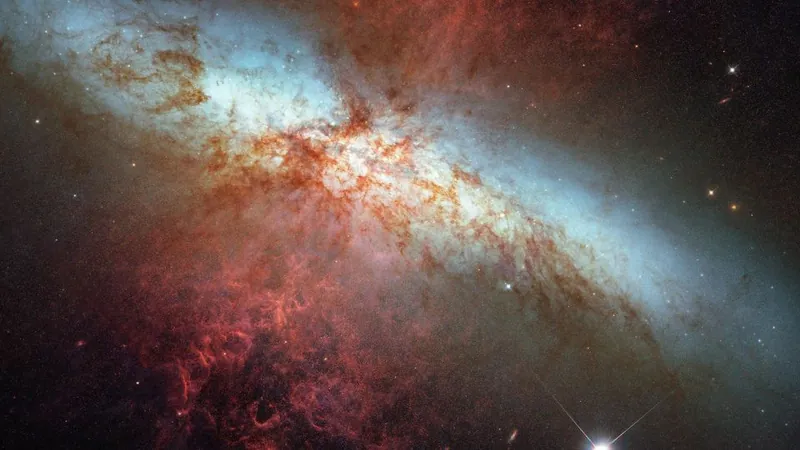
Could Supernovas Have Triggered Earth’s Most Cataclysmic Extinctions? New Study Raises Alarm
2025-03-20
Author: Wei
Introduction
In a groundbreaking study, researchers have proposed that explosive supernovas might have been catalysts for two of Earth’s most significant mass extinctions, events that have long puzzled scientists. This theory adds a cosmic twist to our understanding of the dramatic shifts in biodiversity that have shaped the planet.
Understanding Supernovas
Supernovas occur during the turbulent final moments of massive stars, culminating in a colossal thermonuclear explosion that obliterates the star and emits a staggering amount of radiation and material into space. A team of researchers connected the dots between these celestial eruptions and Earth’s past extinction events by calculating the rate of supernova occurrences among stars located within 65 light-years of the sun over the past billion years. Their findings suggest that roughly 2.5 supernovas could have impacted Earth every billion years, potentially leading to one or two significant cosmic events during the last 500 million years, a period critical to the evolution of life.
The Extinction Events
Nick Wright, co-author and physicist at Keele University in the UK, stated that while the supernova rate is lower than previous estimates, it is still plausible that these cosmic explosions could correlate with mass extinction events. The Earth has experienced five major extinction events in the last 500 million years, during which a vast number of species from both terrestrial and marine environments vanished in a short geological span.
Connecting Evidence
The evidence presented does not definitively connect supernovas to specific extinction events but suggests a possibility that warrants further investigation. The researchers particularly point to two major extinction events: the Late Devonian extinction around 372 million years ago and the Late Ordovician extinction approximately 445 million years ago. They hypothesize that these supernova explosions might have compromised Earth’s protective ozone layer, exposing life forms to deadly radiation and triggering catastrophic environmental shifts.
Impact on Biodiversity
During the Devonian period, terrestrial life flourished for the first time, evolving from aquatic environments. This evolution faced a brutal setback with the extinction of early land plants and animals, along with numerous marine species. Meanwhile, the Late Ordovician extinction saw about 85% of species, primarily marine, disappear in what was a critical time for marine biodiversity.
Expert Opinions
Experts have weighed in on this provocative hypothesis. Mike Benton, a professor of vertebrate paleontology, emphasized the need for correlation between specific supernova events and geological timelines. There is a strong interest in tracing rare elements like iron-60, which originates from supernova explosions, to see if deposits can be found in the sedimentary record of extinction periods.
Meanwhile, Paul Wignall, a paleoenvironments professor, pointed out that while it’s not the first time the supernova extinction concept has been introduced, substantial evidence is key for establishing any links. Researchers are keen on finding markers of these explosions that could corroborate the hypothesis, similar to how the "iridium anomaly" provided compelling evidence for the asteroid impact that doomed the dinosaurs.
Compounding Theories
Though the idea of a supernova-triggered extinction is intriguing, other mass extinction theories suggest they are often the result of a series of compounding catastrophic events—examples include massive volcanic eruptions that have escalated environmental crises over time.
Conclusion
In light of these fresh insights, Wright and his team aim to shed light on the new supernova timeline they have discovered, igniting discussions about the origins of past extinctions. The connection between cosmic events and biological evolution continues to spark curiosity, as researchers explore the delicate balance of life on our planet, often shaped by colossal forces beyond our atmosphere.



 Brasil (PT)
Brasil (PT)
 Canada (EN)
Canada (EN)
 Chile (ES)
Chile (ES)
 Česko (CS)
Česko (CS)
 대한민국 (KO)
대한민국 (KO)
 España (ES)
España (ES)
 France (FR)
France (FR)
 Hong Kong (EN)
Hong Kong (EN)
 Italia (IT)
Italia (IT)
 日本 (JA)
日本 (JA)
 Magyarország (HU)
Magyarország (HU)
 Norge (NO)
Norge (NO)
 Polska (PL)
Polska (PL)
 Schweiz (DE)
Schweiz (DE)
 Singapore (EN)
Singapore (EN)
 Sverige (SV)
Sverige (SV)
 Suomi (FI)
Suomi (FI)
 Türkiye (TR)
Türkiye (TR)
 الإمارات العربية المتحدة (AR)
الإمارات العربية المتحدة (AR)